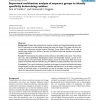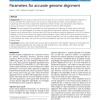120 search results - page 4 / 24 » How Much Can We Gain from Supervised Word Alignment |
CVPR
2009
IEEE
15 years 5 months ago
2009
IEEE
The goal of this work is to automatically learn a large
number of British Sign Language (BSL) signs from TV
broadcasts. We achieve this by using the supervisory information
avai...
BMCBI
2007
13 years 10 months ago
2007
Background: Proteins that evolve from a common ancestor can change functionality over time, and it is important to be able identify residues that cause this change. In this paper ...
NLE
2007
13 years 9 months ago
2007
We address the problem of extracting bilingual chunk pairs from parallel text to create training sets for statistical machine translation. We formulate the problem in terms of a s...
ACL
2010
13 years 8 months ago
2010
We present a discriminative model that directly predicts which set of phrasal translation rules should be extracted from a sentence pair. Our model scores extraction sets: nested ...
BMCBI
2010
13 years 10 months ago
2010
Background: Genome sequence alignments form the basis of much research. Genome alignment depends on various mundane but critical choices, such as how to mask repeats and which sco...


